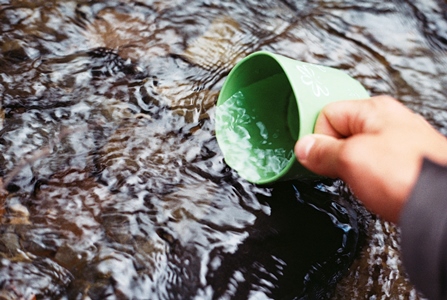YOUR WATERCRAFT.
Rinse your boat, your gear, and your dog to prevent invasives from spreading.
Non-native invasive species that live in the water, such as Zebra mussels and Eurasian milfoil, can cling to boats, trailers, rope, and anything else that touches the water. When that item re-submerges elsewhere, the stowaways escape, procreating to the detriment of local species and recreational users.
Some states have passed regulations prohibiting putting in or taking out a boat without first cleaning and draining it. But even where it’s not the law, it’s a good practice.
“‘
Clean, drain, dry’ is the mantra. Every boat matters,” says Leah Elwell, an aquatic biologist and program director for the Invasive Species Action Network, a non-profit organization trying to reduce the human-caused spread of invasive species.
“If your craft is non-motorized, such as a canoe or a kayak, it’s simple,” says Elwell. “Check visually and feel around for mud or plant material. You can rinse with the water you just came out of, then make sure your boat is dry to the touch before using it in another body of water. With motorboats, more places can harbor unwanted hitchhikers, such as a live well and the bilge. Clean your anchor lines, coolers, buckets, PFDs, and especially anything that has standing water in it.”
But lay off the cleaning fluids, such as bleach or Formula 409. According to Elwell, household disinfectants won’t kill every invasive species, and they present conservation issues when you rinse them off. Pressurized hot water – 120 to 140 degrees F – at boat cleaning stations works well, but Elwell warns boaters not to try this method at home due to the risk of burns.
Drying also does the deed. The longer a boat is dry between uses, the higher the chance that unwanted plant and animal matter will die. One day is not enough. The U.S. Fish and Wildlife Service recommends at least five days.
The same goes for Rover. If your dog leaps into the local lake and you plan to visit another lake the same day, rinse him off between dips. You need a rinse too if you’ve waded in to fish. Many states require the use of non-felt-soled wading shoes because felt can harbor invasives and takes a long time to dry. Be sure to rinse your waders, net, and tackle. Don’t toss unused bait into the water or release fish from one body of water into another – this could introduce non-natives into new habitats. Waterfowl hunters, stand-up-paddlers, and inner-tubers should take similar steps to avoid transporting nonnatives.
Whatever your aquatic avocation, if you pursue it in multiple locations, Elwell suggests getting a spare set of gear to use while the other set is drying. “All equipment should be cleaned, drained, and dried every time,” emphasizes Elwell. “We don’t have invasives everywhere because we’ve taken these steps. Make it a habit. It’s like recycling –something we should just do.”
SIPPING FROM A STREAM.
Purify wild water sources to avoid waterborne illnesses.

For years, government officials and guides have warned us to avoid drinking water straight from a lake or stream for fear of contracting a waterborne illness, particularly giardia lamblia or “beaver fever” – so called because beavers are a major carrier of this nasty parasite. If a beaver or another animal poops in the water upstream from where you drink it, you are at risk.
“Giardia is not fun,” says Marco Johnson, field staffing director and a Field and Wilderness Medicine instructor for the National Outdoor Leadership School, a nonprofit that teaches wilderness skills and leadership. “It’s a 20-pound weight-loss program that includes terrible cramps, diarrhea, vomiting, and high-powered antibiotics…. You can’t see [parasites]. Clear running water doesn’t mean, it’s safe.”
For years, experts preached boiling water from streams or lakes for four minutes before drinking it. Then came iodine tablets and other chemical treatments, a variety of filters, and, most recently, ultraviolet rays to kill whatever germs may be hiding in your water source. Each has its pros and cons.
Boiling. “The best way to kill everything is to bring water to a rolling boil,” says Johnson. “You don’t need to boil it for four minutes. That was the government’s way of ensuring you actually boil the water.” Bring your water up to a vigorous boil and you’re done (although the water will need time to cool for drinking).
Filtering. Suited for cleaning debris out of murky water, today’s filters include “microfiltration membranes” that capture bacteria and viruses as well as parasites (although some manufacturers recommend using a chemical treatment in addition to the filter). If you need to fill more than one bottle of water, filters can be bulky to carry and difficult to dry thoroughly. In addition, intake hoses and filters can also clog up with debris.
Chemicals. Instructors at the National Outdoor Leadership School use iodine tablets or chlorine-based water treatment drops (such as Aquamira®) to treat water during training courses. These treatments are compact, lightweight, and inexpensive. They also kill the parasites, viruses, and bacteria found in North American water sources. However, they take time to work – 30 minutes or longer – and don’t address the issue of debris in your water.
Ultraviolet Light. SteriPEN® and similar devices sterilize water using ultraviolet light. Most work by stirring the device in a bottle of water. However, if there is detritus or sediment clouding the water, this method won’t work well. (SteriPEN’s Quantum™ four-liter treatment system includes a filter.) Ultraviolet light devices work quickly but require batteries and can be expensive.
Picking the right water purifying system is ultimately a matter of personal preference, storage space, and budget. The key is to pick one and use it for every sip rather than playing “water roulette.”